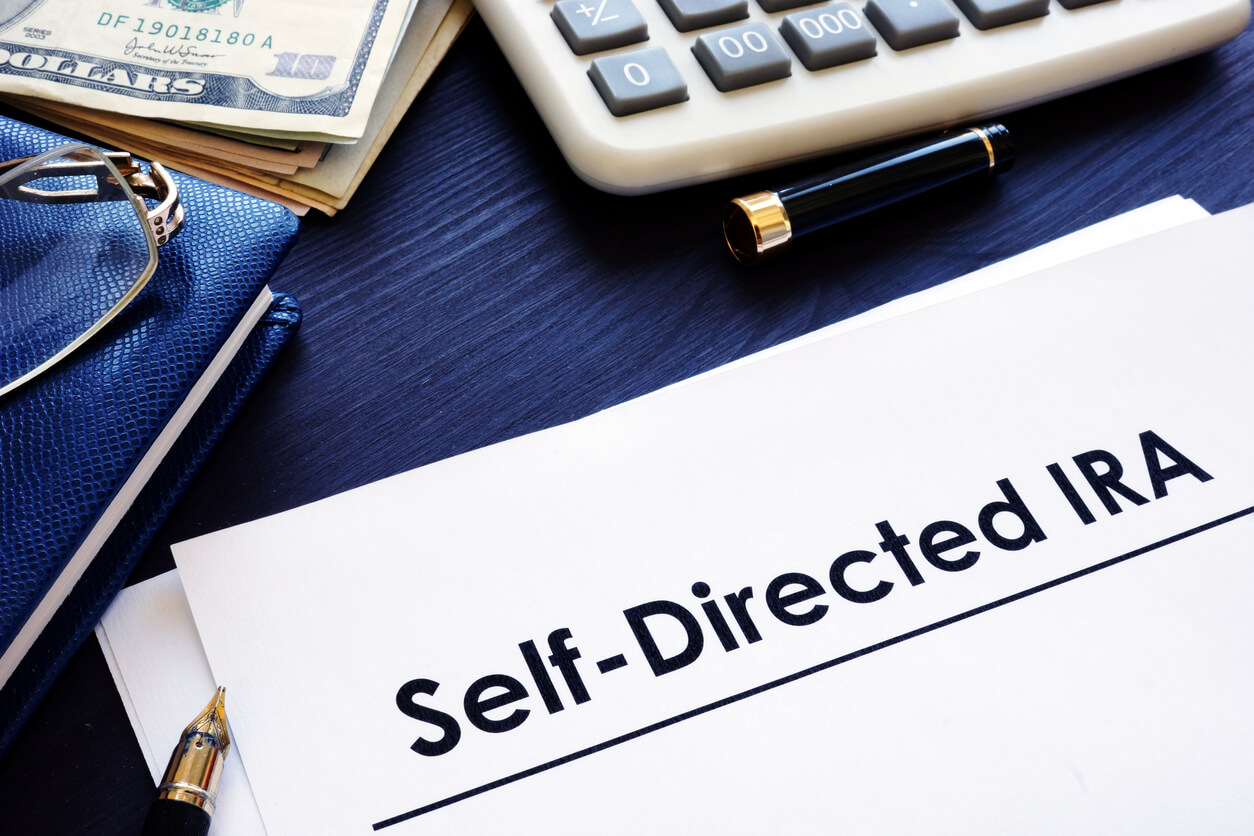Understanding Self-Directed IRAs & IRS Guidelines
A self-directed IRA can offer a wider range of investment options than traditional IRAs, but there are some complexities to understand.
This article will give you an overview of the IRS regulations and restrictions associated with SDIRAs. You'll learn about prohibited transactions, contributions and withdrawals, fees and expenses, reporting requirements, tax considerations and more.
With this information in hand, you can make an informed decision about whether a this type of IRA account is the best retirement option for you.
What is a Self-Directed IRA?
A Self-Directed IRA (SDIRA) is an individual retirement account that allows you to choose how the funds in the account are invested. The investments can be traditional stocks, bonds, and mutual funds, as well as alternative investments like precious metals, commodities, private placements, real estate and more.
SDIRAs require a qualified custodian to hold the account's investments and ensure compliance with IRS rules. Unlike regular IRAs that are limited to certain types of investments approved by the IRS, these accounts have no income limits and give you more freedom when it comes to investment choices.
This makes them attractive for investors who want more control over their retirement money or those looking for higher returns than traditional IRAs offer. However, since these accounts involve different types of investments than regular IRAs do, there is a greater risk involved in using them.
It's essential to do your homework before opening an account so you understand all of the rules regarding these accounts. You'll also need to research potential custodians and find one who meets your needs and provides quality customer service.
When choosing a custodian it's important to look at their fee structure as well as any other services they offer such as bill paying or tax filing assistance. You should also be aware that some prohibited transactions may limit what types of investments can be made with an self directed account.
These include life insurance contracts, corporation stocks, transactions between related parties or entities, collectibles such as art or antiques and certain foreign currencies or securities among other things. It's best to consult a financial advisor before investing in order to ensure that you stay compliant with IRS regulations and maximize your returns safely within the guidelines set forth by the law.
1. Prohibited Transactions for Self Directed IRA Accounts
Certain transactions prohibited by the IRS when it comes to SDIRAs include investing in life insurance or collectibles, so it's important to do your research and consult with a financial advisor before making any decisions.
It is also important to remember that a Self Directed IRA provider cannot offer financial advice, so make sure that you understand the rules of investing before taking on the responsibility of managing your own retirement funds.
It also requires being familiar with fees associated with setting up and maintaining an account as well as how long each investment holds its value (i.e., liquidity). In addition to this, if you're new to investing or don't have much experience trading securities, then a Self directed IRA may be too advanced for you and you may need to seek out professional advice from a financial advisor first.
Remember that although self-directed IRAs provide investors more control over their retirement savings than traditional IRAs do, they still must follow all applicable laws and regulations set out by the IRS regarding permissible investments and transactions within these accounts; failure to do so could result in severe penalties ranging from back taxes to early withdrawal fees or even criminal charges depending on severity of violation. Therefore, it's important to stay on top of current regulations and be mindful of any changes made by the government before committing funds into one of these accounts.
2. Contributions and Withdrawals
When it comes to a Self Directed IRA accoint, it's essential to have an understanding of the contribution and withdrawal limits mandated by the IRS—which are the same as those for traditional or Roth IRAs.
The annual contribution limit is $6,500 per year ($7,500 if you're 50 or older). This means that any contributions above this limit will be subject to taxes and penalties.
Contributions into your account must come from sources other than a loan, such as regular income or savings. In addition to this, you cannot borrow against funds held in an SDIRA; although you can take out loans secured by assets held in the account.
Withdrawals must also be completed correctly to avoid tax penalties; distributions must adhere to rules set by the IRS regarding eligibility and timing. The amount withdrawn cannot exceed what has been contributed either through contributions or earnings on investments within the account.
It's also important to note that withdrawals or distributions are made from these types of accounts prior to age 59 1/2 may result in a 10% early withdrawal penalty. Rollovers from another qualified retirement plan are not subject to taxes or penalties when properly handled according to IRS guidelines.
Making sure all of these pieces fit together is essential when setting up withdrawals from your account and consulting with a financial advisor can help ensure compliance with IRS regulations. This can protect against facing unexpected taxation consequences down the line.
3. Self Directed IRA Investment Options
You can diversify your retirement investments with a self-directed IRA, giving you access to alternative assets such as precious metals, commodities, and real estate. This type of account also allows for more control over how you invest your money, but it's important to understand the IRS rules regarding these investments.
While some investments are prohibited, other investment types are allowed; however, some require additional due diligence on behalf of the investor. For example, real estate investments are not very liquid assets so buyers need to be sure they have enough cash flow from tenants to cover expenses associated with their property holdings.
Self Directed IRA custodians cannot offer financial advice but they are responsible for ensuring compliance with IRS regulations and holding your assets securely. It is important to note that there is a complex fee structure associated with your account which includes a one-time establishment fee as well as annual renewal fees and fees for investment bill paying.
It is wise to research all fees prior to opening an account so you know what costs you will incur over time when maintaining your sef deirected account. The same contribution limits apply in 2023 to these IRAs accounts as traditional and Roth IRAs: $6,500 per year ($7,500 if you're 50 or older).
Knowing these limitations before getting started can help keep your retirement savings on track while still allowing flexibility in terms of where those funds are invested. These IRA accounts may not suitable for novice investors due their complexity but experienced investors can benefit from this unique type of retirement account by having greater control over their retirement portfolio without sacrificing tax benefits associated with other traditional accounts.
4. Self Directed IRA Fees and Expenses
Understanding the fees and expenses associated with a Self Directed IRA is essential for making an informed decision, as they can add up quickly. The IRS requires you to pay for certain services, such as account maintenance and investment bill paying. You may also be charged additional fees by the custodian, depending on what type of investments are held in the account. These fees can range from low annual fees to higher one-time establishment fees. It's important to shop around and compare different custodians to ensure you're getting the best deal possible.
Before investing in these accounts, make sure you understand all of the fees associated with it so that you can factor those into your financial planning. Some of these expenses include: a one-time establishment fee; a first-year annual fee; an annual renewal fee; and any other charge related to conducting transactions within your account.
It’s essential to read all terms and conditions carefully before signing up, including any fine print that might not be immediately apparent at first glance. You should also consider any taxes or penalties that might be imposed if you withdraw funds from your account early or fail to comply with IRS rules.
There may also be special tax treatments for certain investments such as precious metals or real estate, which could affect how much tax you owe each year. Get advice from a professional about how this will work for your particular situation before investing in anything through an SDIRA.
It’s wise to take some time upfront researching all of the costs involved with setting up and maintaining an account so there are no surprises down the road. Comparing different custodians is key when it comes to selecting one with reasonable rates and quality service—which is especially important if you plan on holding illiquid assets like real estate within your account.
With careful consideration of all factors involved, having an understanding of self-directed IRA IRS guidelines will help ensure that your retirement savings are being managed correctly and efficiently over time.
5. Self-Directed IRA Reporting Requirements
Staying up-to-date with the IRS reporting requirements is key to making sure you're compliant and maximizing your retirement savings. As an account holder, you must report all contributions, distributions, and investment gains or losses on your annual tax returns. You'll also need to report any fees or expenses that are paid out of the account. To ensure accuracy, it's important to keep good records of all transactions throughout the year.
Each year, you must file a Form 5498 with the IRS to report contributions that have been made during the prior calendar year. This form also reports any rollovers from other qualified plans into your account as well as fair market values at the end of each tax year. It's essential that this information is accurate in order to precisely calculate taxes owed on any distributions taken from the account during the year.
When taking withdrawals, you must be aware of potential tax implications. Distributions may be subject to both federal and state taxes depending on which type of contribution was used to fund them. If required minimum distributions (RMDs) are not taken when necessary, there could be hefty penalties imposed by the IRS so make sure to consult with a professional before taking such action.
Proper paperwork must be kept up with throughout each tax year. Any discrepancies between what was reported on tax forms versus actual activity in accounts should be corrected promptly in order to avoid costly mistakes down the road. Keeping thorough records will help ensure compliance with IRS regulations and maximize retirement savings over time by avoiding unnecessary fees or penalties due to inaccurate reporting practices.
6. Tax Considerations
As mentioned, it's essential to be mindful of the tax implications associated with an SDIRA, or else you could face hefty penalties and miss out on maximizing your retirement savings.
The IRS requires that all income, gains, losses, and deductions associated with SDIRAs are reported on Form 1040. Additionally, any distributions taken must be reported as taxable income in the year it was received. If a distribution is taken prior to reaching age 59 ½, the investor may also incur an additional 10% early withdrawal penalty.
When filing taxes for an account holder who has made contributions during the tax year, Form 5498 should also be filed. This form reports contributions made to an IRA or Roth IRA account during the past year and can help investors track their contribution limits for future years.
Investors must also keep accurate records of all transactions throughout the year so they can report them when filing taxes each spring.
It's important to note that while most investments held within a self-directed IRA will not face taxation until withdrawals are made from the account, there are certain investments that may trigger taxable events before then, such as dividends paid out by REITs (Real Estate Investment Trusts). Investors should take this into consideration when investing in these types of assets within their plan accordingly for potential tax consequences down the line.
Finally, if you're considering opening a self-directed IRA it's important to speak with a financial advisor first so they can help ensure you understand all aspects of managing your own retirement portfolio, including how different investments might impact your overall tax liability come April 15th.
In Summary
Now that you've got a better understanding of how this IRA works and the IRS regulations associated with them, you can make an informed decision about whether this type of retirement account is right for you.
Keep in mind that these accounts require more due diligence on your part. You'll need to give careful consideration to investment options, fees and expenses, tax considerations, and reporting requirements.
With the right knowledge and guidance, a SDIRA could be just what you need to achieve your financial goals. Read this article for more information on self-directed IRA accounts.
Find Out the Best Place to Buy Gold Online
Check Out Your Options
Review our analysis of the Top Gold IRA Players on the Market



